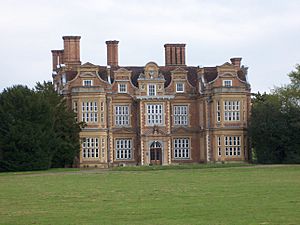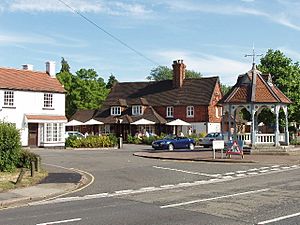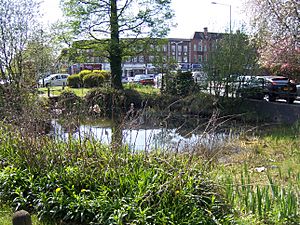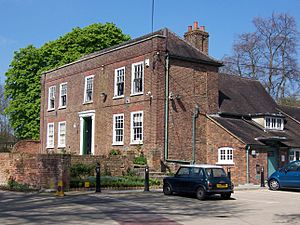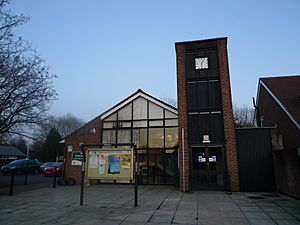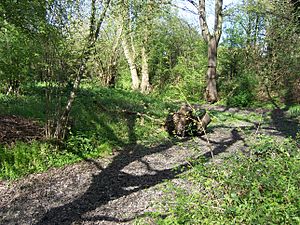Ickenham facts for kids
Quick facts for kids Ickenham |
|
|---|---|
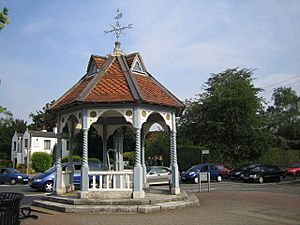 Ickenham Village Pump |
|
| Population | 10,387 (2011) |
| OS grid reference | TQ075855 |
| • Charing Cross | 14.3 mi (23.0 km) ESE |
| London borough | |
| Ceremonial county | Greater London |
| Region | |
| Country | England |
| Sovereign state | United Kingdom |
| Post town | UXBRIDGE |
| Postcode district | UB10 |
| Dialling code | 01895 |
| Police | Metropolitan |
| Fire | London |
| Ambulance | London |
| EU Parliament | London |
| UK Parliament |
|
| London Assembly |
|
Ickenham is a friendly area in Greater London, located in the northern part of Uxbridge. It's part of the London Borough of Hillingdon.
Even though Ickenham hasn't seen huge historical events, people have lived here for a very long time. Archaeologists have found signs of settlements from the Roman times. The area is even mentioned in the Domesday Book, a famous survey from 1086. You can still see buildings from the 14th, 15th, and 16th centuries that have been carefully restored.
Ickenham was once divided into four main areas, called manors. Later, there were two main ones: Ickenham and Swakeleys. The old manor house of Swakeleys, a beautiful 17th-century Jacobean mansion called Swakeleys House, is still standing today. Much of the land around Swakeleys House was sold for building homes in the 1920s. Ickenham's own manor house, Manor Farm, is now part of Long Lane Farm. A military base, RAF West Ruislip, opened in 1917. It was later used by the U.S. Naval Activities, United Kingdom from 1975 to 2006.
In 1901, only 329 people lived in Ickenham. By 2011, the population had grown to 10,387! When a railway station opened in Ickenham, it became much easier for people to travel to London for work. This led to many new homes being built. Ickenham grew even more when a large part of the Swakeleys estate was sold for housing in 1922. It became part of what was known as "Metro-land", areas that grew because of the Metropolitan Railway.
Contents
Discovering Ickenham's Past
What's in a Name?
The name 'Ickenham' means 'the home or village of Tic(c)a'. The 'T' sound was lost a long time ago, around the 13th or 14th century. This happened because people confused it with the Middle English word for 'at'.
Ickenham is mentioned three times in the Domesday Book from 1086. This book was a huge survey of England ordered by William the Conqueror. It described Ickenham as mostly flat land with clay soil, except near the River Pinn. In 1994, archaeologists found signs of Roman fields from the 1st and 2nd centuries. They also found pieces of pottery. It seems the area might have been empty for a while after the Romans left Britain around AD 410.
Early Village Life
Ickenham was first divided into four manors. Over time, these merged into two main ones: Ickenham and Swakeleys. The lords, or owners, of these manors lived in grand houses. The Crosier family, who owned a lot of land nearby, moved to Ickenham in the 1500s.
The manor house for Swakeleys was named after Robert Swalcliffe, who owned it in the 1300s. The Swakeleys House you see today wasn't the first house on the site. The original was built around the 1300s, probably from wood and mud. The current brick house was built in 1638 for Sir Edmund Wright, who later became the Lord Mayor of London.
A church in Ickenham isn't mentioned in the Domesday Book. This means people probably went to nearby Harefield for church services. The oldest parts of St Giles' Church date back to 1335. The church's bell tower was built in the 1400s.
The Village Pump and Pond
'The Pump' is a very important local landmark. It was given to the village by Charlotte Gell. This water pump stands near the village pond where Swakeleys Road and Long Lane meet. After Charlotte Gell died in 1863, her will said that a water pump should be built for the community. So, in 1866, the pump was installed. The village pond next to it was dug at the same time.
In 1857, Charlotte Gell also gave some land near St Giles' Church. This land was used to build five almshouses. These were homes for long-serving helpers of the Gell family or for Ickenham residents who were part of the Church of England. These cottages are still there and are looked after by St Giles' Church.
Next to the pump is the Coach & Horses pub. It first started selling drinks in 1759, but the building itself is much older, from the 1500s.
Growing into a Town
On September 25, 1905, the Metropolitan Railway opened a small stop in Ickenham. This was after the Ickenham Parish Council asked for it. The railway company didn't think many people would use it, so they built a simple halt. This new stop brought visitors from London who wanted a day out in the countryside. Local villagers would sell flowers and serve tea to these visitors. The halt was later rebuilt as a proper station in the 1970s.
The marathon event of the 1908 Summer Olympics in London actually passed through Ickenham and Uxbridge!
Because of the railway, more people moved to Ickenham and started traveling to London for work. On July 5, 1922, a large part of the Swakeleys estate was sold for building homes. New roads were created for these homes, like Warren Road and Swakeleys Drive. Shops were built around Swakeleys Road, and houses were built along it.
A military base, RAF West Ruislip, opened in 1917. It was first used by the British Royal Air Force. Later, between 1955 and 1975, the United States Air Force used it. After that, the U.S. Naval Activities, United Kingdom leased the site for the American Naval Exchange until 2006. The site was cleared in 2007 and is now being redeveloped for new homes.
The original village school was built in 1866. But it became too crowded. In 1929, the village school closed, and younger children moved to the village hall. The road was made wider in 1934, and the old school building had to be taken down.
The village pump was used until 1914. Its handle was removed in 1921 for safekeeping but was never put back. In 2004, the pump was restored, and a new handle was added.
New schools were built as Ickenham grew. Breakspear Primary School opened in 1937, and Glebe Primary in 1952. The Roman Catholic secondary school Douay Martyrs was built in 1962. Vyners School opened in 1960.
The village hall was built in 1926. It was opened by Princess Victoria. During the Second World War, it was used as a restaurant. It has also been a bank and a place where people vote.
Middlesex County Council bought Ickenham Hall in 1948 to turn it into a youth center. In 1968, a theatre was built behind the hall. It was later named the Compass Theatre. A new building connecting the hall and the theatre was built in 1976.
During the Second World War, Swakeleys House was used by the military. A searchlight battery was set up in its grounds.
The village library opened in 1962. In the 1980s, St Giles' church celebrated its 650th anniversary. The US Navy left the military base in 2006, and the site is now being redeveloped for homes. The local library was updated in 2009 and reopened in March 2010.
In September 2012, a garden was opened in Swakeleys Park to celebrate the Diamond Jubilee of Elizabeth II. It has a landscaped area and benches around a stone monument.
Who Lives in Ickenham?
According to the 2011 census, most people in Ickenham (72%) are White British. The next largest groups are Indians (10.9%) and other White people (3.6%).
Most people (81.2%) living in Ickenham were born in England. Other common birthplaces include India (3%), Ireland (1.6%), and Kenya (1.3%).
The most common religions in Ickenham are Christians (60%). Many people (17.9%) say they have no religion. Other religions include Hindus (5.8%) and Sikhs (4.3%).
Almost half of the homes (45.3%) are detached houses. About 40.3% are semi-detached, and 9.4% are flats or apartments.
Learning in Ickenham
Ickenham has several primary schools, including Breakspear School, Breakspear Junior School, and Glebe Primary School. For secondary education, students can attend The Douay Martyrs School and Vyners School.
There's also Pentland Field School, a special school on the old USA Navy site. This school is for young people aged 4 to 19 who have severe to moderate learning difficulties.
Sports and Community Groups
Ickenham has active sports clubs like Ickenham Cricket Club and Ickenham Rugby Club. Hillingdon Athletics Club, which started in the 1960s, also attracts many athletes from Ickenham.
The Ickenham and District Society of Model Engineers started in 1948. They build and show miniature locomotives. Their clubhouse opened in 1955 near the Coach & Horses pub. You can visit their miniature railway on the first Saturday of each month.
Ickenham's residents' association was formed in 1924. This group works to protect the community. For example, they have helped stop large developments that they felt would harm the town.
Getting Around Ickenham
Ickenham tube station is served by the Metropolitan and Piccadilly London Underground lines.
West Ruislip station is on the border of Ruislip and Ickenham. It's served by the Central line and the Chiltern Main Line.
Local London Buses routes U1, U10, and 278 serve Ickenham. Main roads like B467 (Swakeleys Road) and B466 (Long Lane) meet in the center of Ickenham. They connect Ickenham to nearby areas like Harefield, Hillingdon, and Ruislip.
Famous Places and Events
Pynchester Moat
The Pynchester Moat is a Scheduled Ancient Monument near the River Pinn. It's usually dry in the summer, but you can still see the moat that once surrounded a manor house. Digs in the 1960s found pottery and an oven from the 14th or 15th century. People believe the house inside the moat was "Pynchester," owned by the Hastings family in the 1500s.
The moat is a cool spot to visit on the Celandine Route. This is a 12-mile walk along the River Pinn from Pinner to the Grand Union Canal at Cowley.
Swakeleys House
Swakeleys House Built between 1629 and 1638, Swakeleys House replaced an older building from the 1300s. Over the years, different groups owned the house. In the 1980s, three local people bought and restored it. Since 2009, the house has been open to the public one day a year as part of Open House London.
Ickenham Festival
The Ickenham Festival happens every two years since 1976. It started to show off all the different groups and societies in the area. The festival usually has a big charity gala day in June. Various groups, like Scouts and schools, parade through the town. The day ends with a large fair in the grounds of Swakeleys House. Fireworks light up the sky to mark the end of the festival. In 2014, the Gala moved to the grounds of Vyners School.
Famous People from Ickenham
- Roger Crab (1621-1680), a unique English soldier and writer, lived as a hermit in Ickenham from 1652 to 1657. He was known for his simple lifestyle and being a vegetarian.
- Steve Conway (1920–1952), a popular singer, lived in Ickenham.
- Cellist Florence Hooton (1912-1988) and her husband, violinist David Martin (1911-1982), lived in Ickenham.
- Anna Rose O'Sullivan (born 1994), a talented ballerina and principal dancer with The Royal Ballet, grew up in Ickenham.



